Electromagnetic Waves are invisible energy forms that travel through the universe. Check out this article for more information on electromagnetic waves.
Table of Contents
- What Are Electromagnetic Waves?
- How Are Electromagnetic Waves Formed?
- Graphical Representation of Electromagnetic Waves
- Mathematical Representation of Electromagnetic Waves
- Derivation of the Electromagnetic Wave Equation
- Intensity of Electromagnetic Waves
- Speed of Electromagnetic Waves in Free Space
- Electromagnetic Spectrum
- Applications of Electromagnetic Waves
- FAQs on Electromagnetic Waves
First put forward by James Clerk Maxwell and subsequently confirmed by Heinrich Hertz, electromagnetic waves are created as a result of vibrations between an electric and a magnetic field. More details about the definition and formation of electromagnetic waves along with the graphical and mathematical representations of electromagnetic waves are covered in this article.
What Are Electromagnetic Waves?
Electromagnetic waves, also known as EM waves, are waves that are created as a result of vibrations between an electric field and a magnetic field. Electromagnetic radiations are composed of electromagnetic waves that are created when an electric field comes in contact with the magnetic field. It can also be said that EM waves are the composition of oscillating electric and magnetic fields and are solutions of Maxwell’s equations, which are the fundamental equations of electrodynamics.
How Are Electromagnetic Waves Formed?
Electromagnetic waves are created due to the vibrations between an electric field and a magnetic field. The electric field and magnetic field of an electromagnetic wave are perpendicular to each other and also perpendicular to the direction of the wave. Usually, an electric field is produced by a charged particle. This electric field exerts a force on the other charged particles. Positive charges move in the direction of the field and negative charges move in the direction opposite to that of the field.
A magnetic field is produced by a moving charged particle. This magnetic field exerts a force on the other particles in motion. The force on these charged particles is always perpendicular to the direction of their velocity which only changes the direction of the velocity and not the speed. Thus, the electromagnetic field is produced by an accelerating charged particle.
Electromagnetic waves are electric and magnetic fields travelling through free space with the speed of light ‘c’. A charged particle is accelerating when it oscillates about an equilibrium position. The charged particle with a frequency of oscillation f produces an electromagnetic wave with frequency f. The wavelength λ of this wave is denoted by λ = c/f.
Graphical Representation of Electromagnetic Waves
Electromagnetic waves are represented by a sinusoidal graph that consists of time-varying electric and magnetic fields which are perpendicular to each other. These fields are also perpendicular to the direction of the propagation of waves. Electromagnetic waves are transverse in nature and the highest point of the wave is known as the crest whereas the lowest point is known as a trough. The electromagnetic waves travel at a constant velocity of 3 x 108 m.s-1 in a vacuum.
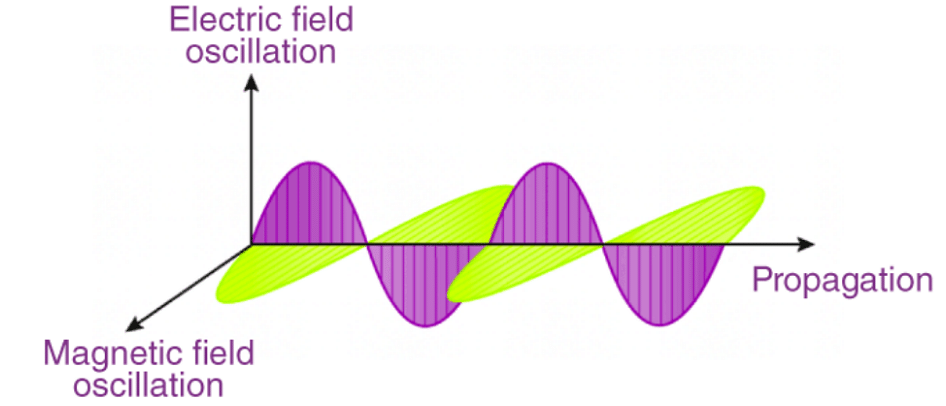
Mathematical Representation of Electromagnetic Waves
A plane electromagnetic wave travelling in the x-direction is denoted by

Where E is the electric field vector and B is the magnetic field vector in the electromagnetic wave.
Maxwell introduced the basic idea of electromagnetic radiation and Hertz experimentally confirmed the existence of an electromagnetic wave.
The direction of propagation of the electromagnetic wave is given by the vector cross-product of the magnetic field and the electric field expressed as

Derivation of the Electromagnetic Wave Equation
The electromagnetic wave equation demonstrates the propagation of electromagnetic waves in a vacuum or through a medium. It is a second-order partial differential equation and is also a 3D form of the wave equation. The homogeneous form of the electromagnetic wave equation is given as
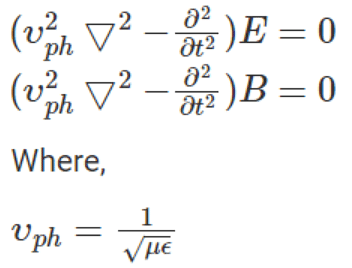
Intensity of Electromagnetic Waves
The intensity of an electromagnetic wave can be defined as the energy crossing per second per unit area perpendicular to the direction of propagation of the electromagnetic waves.
The intensity of an electromagnetic wave at a point is given by
I = Uavc
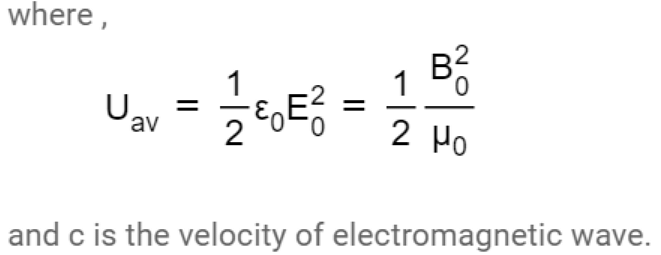
Therefore,
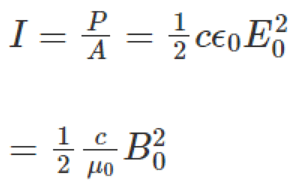
Where E0 and B0 are the maximum values of the electric and magnetic fields respectively.
Speed of Electromagnetic Waves in Free Space
The speed of an electromagnetic wave in free space is expressed as
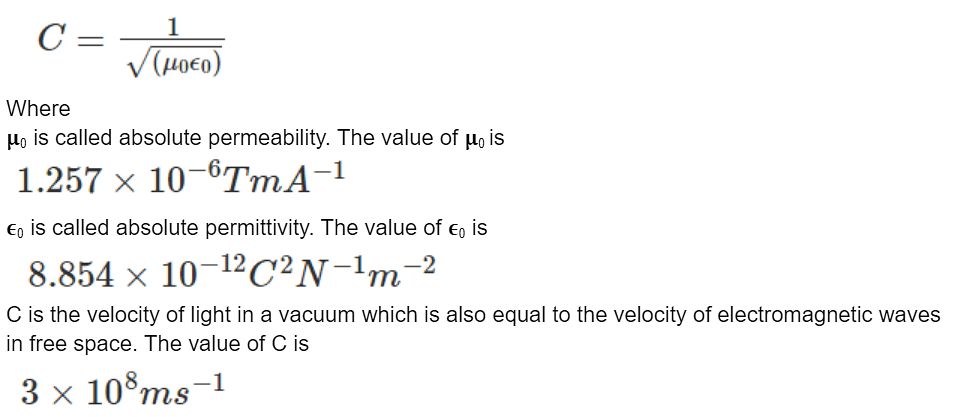
Electromagnetic Spectrum
Electromagnetic waves are classified according to their frequency ‘f’ or according to their wavelength, given by
λ=c/f
The wavelength ranges of different lights are shown as follows:
- For visible light: approx. 400 nm to approx. 700 nm
- For violet light: approx. 400 nm
- For red light: approx. 700 nm

Also Read:
| Electromagnetic Induction | Magnetism and Matter |
Applications of Electromagnetic Waves
Electromagnetic waves are used in a wide range of practical everyday applications such as communication by cell phone and radio broadcasting, WiFi, cooking, vision, medical imaging, and treating cancer. Listed below are a few applications of electromagnetic waves:
- Electromagnetic radiation is used in energy transmission in a vacuum or using no medium at all.
- It plays an important role in communication technology.
- Electromagnetic waves are also used in RADARS.
- UV rays are used to detect forged banknotes as real banknotes do not turn fluorescent under UV light.
- Infrared radiation are used for night vision and in security cameras.
FAQs on Electromagnetic Waves
Q1: Name the property of an electromagnetic wave which is dependent on the medium in which it is travelling.
Ans: Velocity is a property of an electromagnetic wave that is dependent on the medium in which it is travelling. Other properties like wavelength, frequency, and time period are dependent on the source that is producing the wave.
Q2: What is the wavelength of the photon of infrared light with the frequency 2.5 x 1014 Hz?
Ans: Infrared light is a part of the electromagnetic spectrum. The relation between frequency, wavelength, and velocity is given by the formula:
c=fλ
c = 3 x 108 m.s-1
Substituting the values, the wavelength is calculated as = 1.2 x 10-6m
Q3: State if the given statement is true or false: Radio waves and X-rays both are on the electromagnetic spectrum and can travel at the same speed.
Ans: The above statement is true. Waves from the electromagnetic spectrum travel at a constant light speed. Other properties like frequency, energy, and wavelength vary depending on the type of wave and the source producing them but velocity remains constant.
Q4: What is the reason behind photons travelling at the speed of light while the other particles cannot?
Ans: Photons can travel at the speed of light while other particles cannot as they do not have mass.
Q5: State if the given statement is true or false: High-frequency propagation is used so as to increase the accuracy.
Ans: The above statement is true. For an increase in accuracy, the frequency of propagation should be high.
Q6: What is the sequence for the propagation of electromagnetic waves?
Ans: The sequence for electromagnetic wave propagation is the generation, propagation, reflection, and reception.

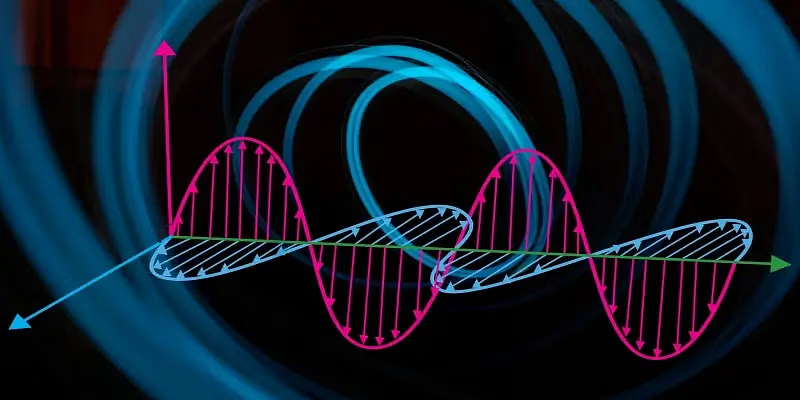






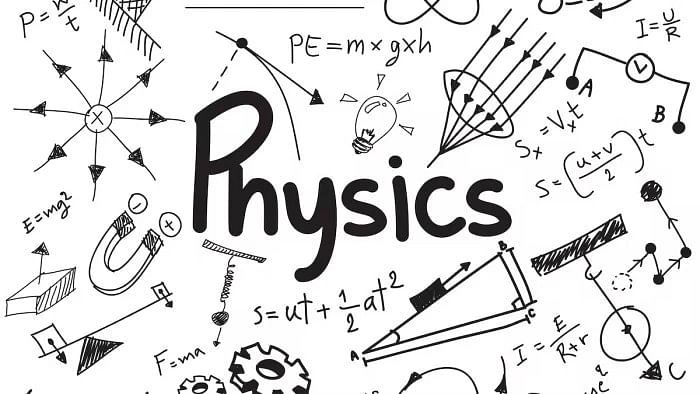














POST YOUR COMMENT